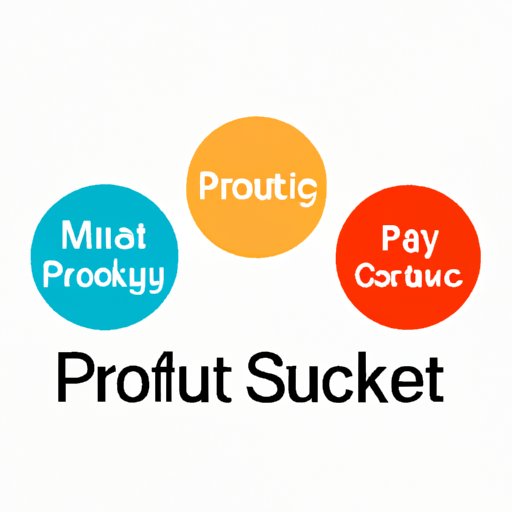
I. Introduction
Product strategy is the roadmap that guides a business in creating, developing, and selling products or services. It serves as a plan that defines what products to create, who to create them for, and how to make them successful in the market. In other words, it is the foundation of a successful business. This article aims to help aspiring entrepreneurs, startups, and business owners develop their own product strategy. By exploring the importance of crafting, creating, and executing a winning strategy, we hope to provide valuable insights and practical tips that can help you succeed in the business world.
II. Crafting a Winning Product Strategy: Tips and Tricks for Startups
Startups face numerous challenges when entering an industry, not the least of which is developing a unique product and bringing it to market. However, many startups overlook the importance of having a product strategy in place to guide them through the development process. Having a well-defined product strategy is essential for startups to succeed in a competitive and fast-paced market. Here are some tips and tricks to help startups craft a winning product strategy:
- Identify your target market: Understand your customers’ needs, preferences, and buying behaviors to create products that will appeal to them.
- Identify market trends: Stay up-to-date on the latest market trends and technologies so that your products are always relevant to your target market.
- Research your competition: Study your competitors’ products, pricing strategies, and sales techniques to identify gaps in the market that you can fill.
- Create a unique value proposition: Develop a messaging strategy that differentiates your product from those of your competitors and highlights the unique value it provides to customers.
- Set clear goals and measurable metrics: Establish clear goals and objectives for your product and track metrics to measure progress towards those goals.
III. The Art of Creating Product Strategy: A Comprehensive Guide
Creating a clear and effective product strategy can be a daunting process, but it is an essential step toward building a successful business. Here is a comprehensive guide to help you create a product strategy:
- Determine your business objectives: Start by defining your business goals and objectives. This will help you determine the role your product will play in achieving those goals.
- Define your target customer: Identify your ideal customer and create a detailed profile of their needs, preferences, behaviors, and buying patterns.
- Conduct market research: Perform a thorough analysis of the market, including industry trends, customer needs, and competition.
- Develop a unique value proposition: Define the unique value that your product provides to customers and communicate it effectively through your messaging strategy.
- Create a roadmap: Develop a product roadmap that outlines the timeline for product development, product launch, and product growth.
- Establish metrics and KPIs: Establish clear metrics that will help you measure the success of your product strategy.
- Continuously evaluate and iterate: Continuously evaluate the success of your product strategy and iterate as necessary based on feedback from customers and metrics.
Examples of successful product strategies include Apple’s iPhone, which revolutionized the smartphone market by creating a unique and innovative product that was tailored to the needs of their target audience. Another example is Amazon’s Prime service, which created a loyalty program that incentivizes customers to shop more frequently and spend more money on the platform.
IV. Why Every Business Needs a Product Strategy: Insights and Examples
In addition to startups, established businesses also benefit from having a product strategy in place. Here are some of the benefits:
- Product strategy ensures that your products are aligned with your business objectives and goals.
- Product strategy helps you identify and address gaps in the market.
- Product strategy enables you to develop products that meet the needs of your target audience.
- Product strategy is essential for effective resource allocation and risk management.
- Product strategy helps you stay ahead of the competition and maintain a competitive edge.
Examples of companies that have benefited from having a strong product strategy include Netflix, which disrupted the entertainment industry with its streaming service, and Tesla, which revolutionized the automotive industry by creating electric vehicles that appeal to a growing sustainability-minded market.
V. The Importance of Product Strategy in a Competitive Market
In a competitive market, having a well-defined product strategy is essential to stand out among competitors. A product strategy gives you the edge that sets your product apart from others in the market. It provides the foundation for creating a unique and valuable product that appeals to your target audience. Conversely, failing to have a product strategy can lead to missed opportunities and wasted resources, resulting in a loss of market share and ultimately, failure.
VI. Product Strategy 101: How to Define, Execute, and Adapt Your Strategy for Success
Here is a step-by-step approach to creating and executing a product strategy:
- Define your product strategy: Use the tips and guidelines outlined in this article to create a well-defined product strategy.
- Execute your product strategy: Use your product roadmap to guide the development of your product and bring it to market.
- Measure success: Track metrics and KPIs to measure the success of your product strategy.
- Adapt as necessary: Continuously evaluate the success of your product strategy, and adapt as necessary based on market trends and customer feedback.
VII. Conclusion
Product strategy is an essential element in building a successful business. It serves as a roadmap that guides the development and launch of products that meet the needs of your target audience and help you achieve your business goals. By crafting, creating, and executing a winning product strategy, you can stay ahead of the competition and maintain a competitive edge. We encourage entrepreneurs, startups, and business owners to develop their own product strategy and seek further resources if needed.




